E-Business Report: Applying Lean Production to Improve InterDigital
VerifiedAdded on 2020/05/28
|8
|1835
|409
Report
AI Summary
This report focuses on enhancing InterDigital's performance through the implementation of lean production practices. It begins with an introduction to InterDigital's business and challenges, particularly in resource management. The discussion section explores various best practices, with a specific emphasis on lean production, a methodology aimed at eliminating waste and improving efficiency. The report details how lean production can be applied to InterDigital, emphasizing the importance of identifying value from the customer's perspective and streamlining processes. The report also highlights the role of advanced information technologies, such as computer-aided production management systems and data governance programs, in supporting lean practices within the company. The conclusion reinforces the benefits of lean production for InterDigital, addressing the complexities of implementation and the need for integrating IT solutions to achieve waste reduction and improved resource control. The report also includes references to support the discussed concepts.

Running head: E-BUSINESS
E-Business
Name of the Student
Name of the University
Author Note
E-Business
Name of the Student
Name of the University
Author Note
Paraphrase This Document
Need a fresh take? Get an instant paraphrase of this document with our AI Paraphraser
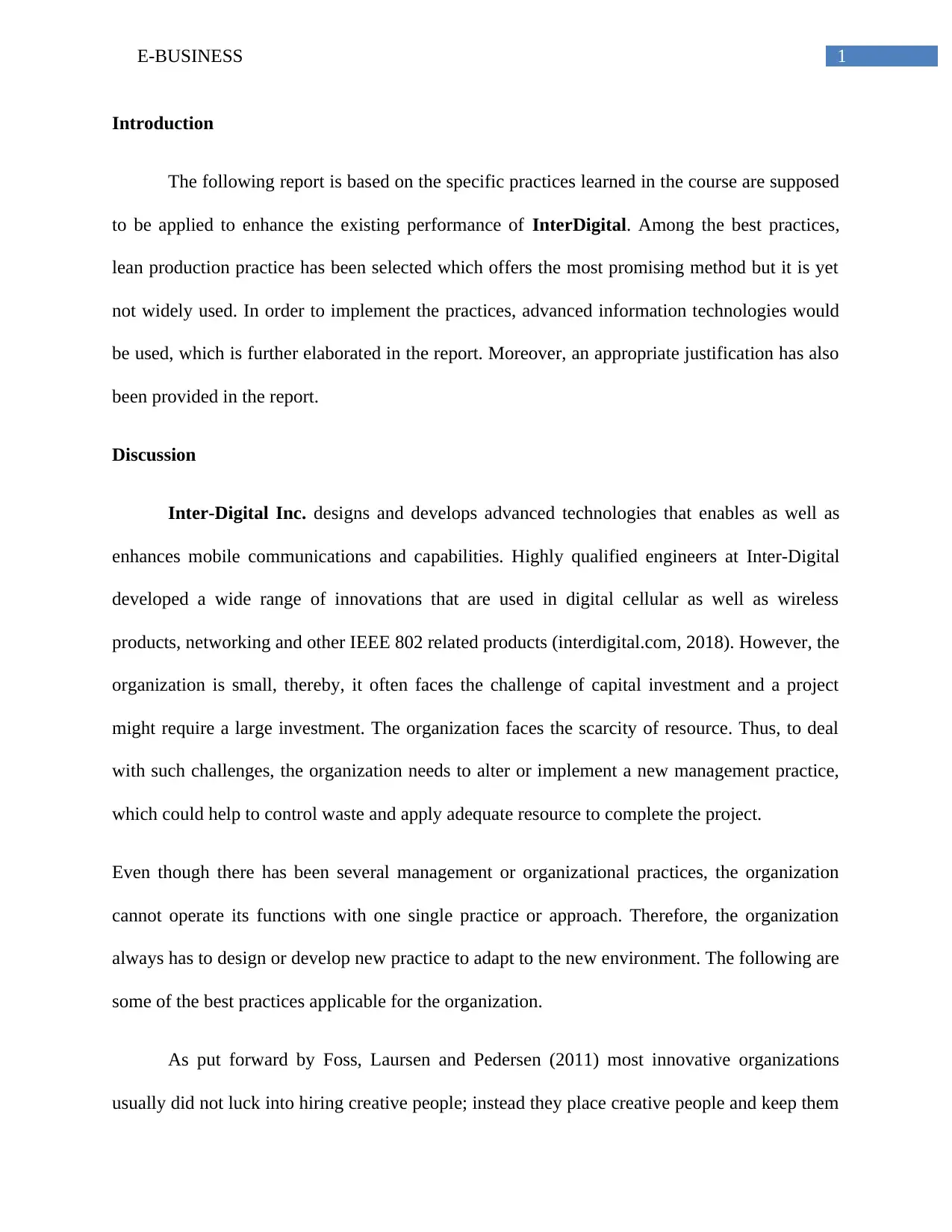
1E-BUSINESS
Introduction
The following report is based on the specific practices learned in the course are supposed
to be applied to enhance the existing performance of InterDigital. Among the best practices,
lean production practice has been selected which offers the most promising method but it is yet
not widely used. In order to implement the practices, advanced information technologies would
be used, which is further elaborated in the report. Moreover, an appropriate justification has also
been provided in the report.
Discussion
Inter-Digital Inc. designs and develops advanced technologies that enables as well as
enhances mobile communications and capabilities. Highly qualified engineers at Inter-Digital
developed a wide range of innovations that are used in digital cellular as well as wireless
products, networking and other IEEE 802 related products (interdigital.com, 2018). However, the
organization is small, thereby, it often faces the challenge of capital investment and a project
might require a large investment. The organization faces the scarcity of resource. Thus, to deal
with such challenges, the organization needs to alter or implement a new management practice,
which could help to control waste and apply adequate resource to complete the project.
Even though there has been several management or organizational practices, the organization
cannot operate its functions with one single practice or approach. Therefore, the organization
always has to design or develop new practice to adapt to the new environment. The following are
some of the best practices applicable for the organization.
As put forward by Foss, Laursen and Pedersen (2011) most innovative organizations
usually did not luck into hiring creative people; instead they place creative people and keep them
Introduction
The following report is based on the specific practices learned in the course are supposed
to be applied to enhance the existing performance of InterDigital. Among the best practices,
lean production practice has been selected which offers the most promising method but it is yet
not widely used. In order to implement the practices, advanced information technologies would
be used, which is further elaborated in the report. Moreover, an appropriate justification has also
been provided in the report.
Discussion
Inter-Digital Inc. designs and develops advanced technologies that enables as well as
enhances mobile communications and capabilities. Highly qualified engineers at Inter-Digital
developed a wide range of innovations that are used in digital cellular as well as wireless
products, networking and other IEEE 802 related products (interdigital.com, 2018). However, the
organization is small, thereby, it often faces the challenge of capital investment and a project
might require a large investment. The organization faces the scarcity of resource. Thus, to deal
with such challenges, the organization needs to alter or implement a new management practice,
which could help to control waste and apply adequate resource to complete the project.
Even though there has been several management or organizational practices, the organization
cannot operate its functions with one single practice or approach. Therefore, the organization
always has to design or develop new practice to adapt to the new environment. The following are
some of the best practices applicable for the organization.
As put forward by Foss, Laursen and Pedersen (2011) most innovative organizations
usually did not luck into hiring creative people; instead they place creative people and keep them
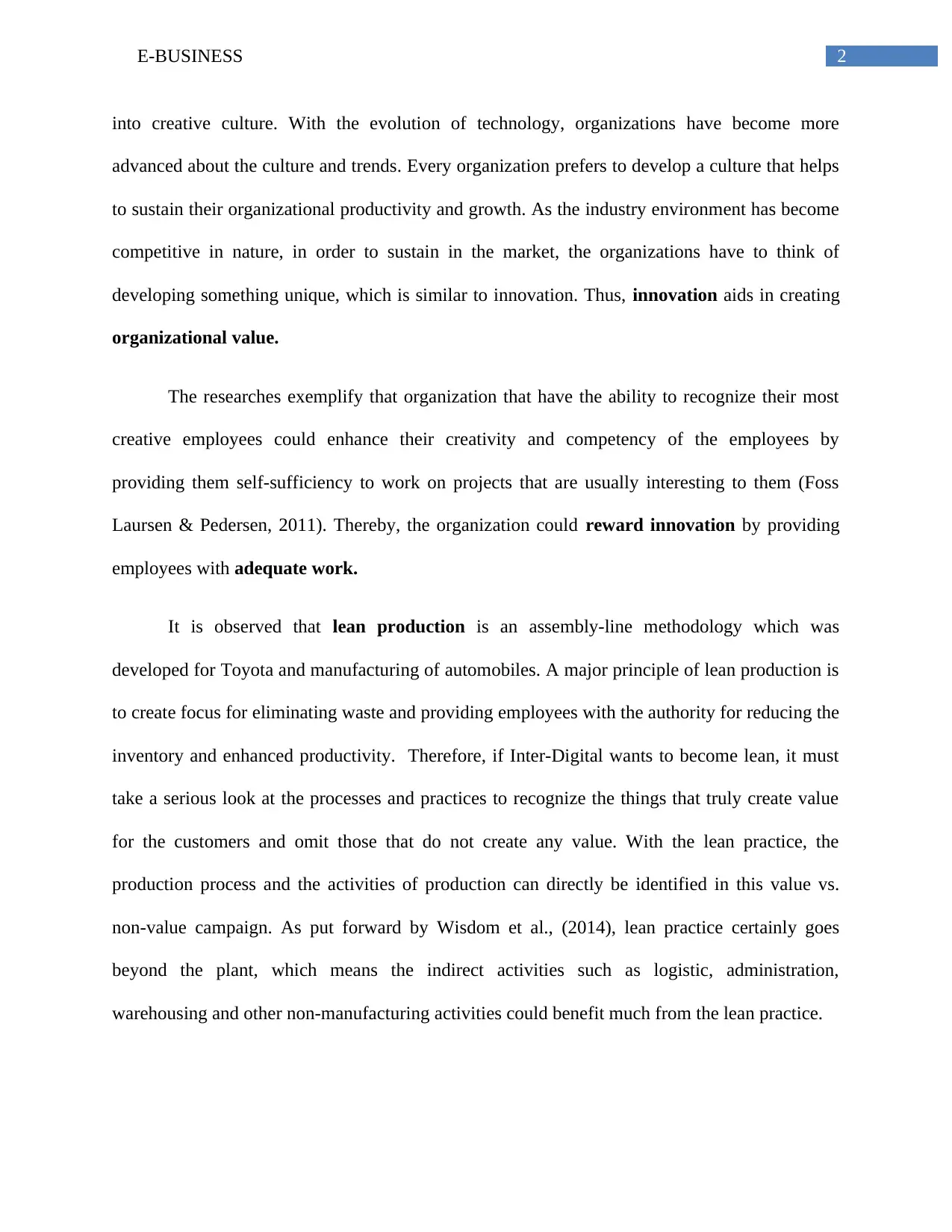
2E-BUSINESS
into creative culture. With the evolution of technology, organizations have become more
advanced about the culture and trends. Every organization prefers to develop a culture that helps
to sustain their organizational productivity and growth. As the industry environment has become
competitive in nature, in order to sustain in the market, the organizations have to think of
developing something unique, which is similar to innovation. Thus, innovation aids in creating
organizational value.
The researches exemplify that organization that have the ability to recognize their most
creative employees could enhance their creativity and competency of the employees by
providing them self-sufficiency to work on projects that are usually interesting to them (Foss
Laursen & Pedersen, 2011). Thereby, the organization could reward innovation by providing
employees with adequate work.
It is observed that lean production is an assembly-line methodology which was
developed for Toyota and manufacturing of automobiles. A major principle of lean production is
to create focus for eliminating waste and providing employees with the authority for reducing the
inventory and enhanced productivity. Therefore, if Inter-Digital wants to become lean, it must
take a serious look at the processes and practices to recognize the things that truly create value
for the customers and omit those that do not create any value. With the lean practice, the
production process and the activities of production can directly be identified in this value vs.
non-value campaign. As put forward by Wisdom et al., (2014), lean practice certainly goes
beyond the plant, which means the indirect activities such as logistic, administration,
warehousing and other non-manufacturing activities could benefit much from the lean practice.
into creative culture. With the evolution of technology, organizations have become more
advanced about the culture and trends. Every organization prefers to develop a culture that helps
to sustain their organizational productivity and growth. As the industry environment has become
competitive in nature, in order to sustain in the market, the organizations have to think of
developing something unique, which is similar to innovation. Thus, innovation aids in creating
organizational value.
The researches exemplify that organization that have the ability to recognize their most
creative employees could enhance their creativity and competency of the employees by
providing them self-sufficiency to work on projects that are usually interesting to them (Foss
Laursen & Pedersen, 2011). Thereby, the organization could reward innovation by providing
employees with adequate work.
It is observed that lean production is an assembly-line methodology which was
developed for Toyota and manufacturing of automobiles. A major principle of lean production is
to create focus for eliminating waste and providing employees with the authority for reducing the
inventory and enhanced productivity. Therefore, if Inter-Digital wants to become lean, it must
take a serious look at the processes and practices to recognize the things that truly create value
for the customers and omit those that do not create any value. With the lean practice, the
production process and the activities of production can directly be identified in this value vs.
non-value campaign. As put forward by Wisdom et al., (2014), lean practice certainly goes
beyond the plant, which means the indirect activities such as logistic, administration,
warehousing and other non-manufacturing activities could benefit much from the lean practice.
⊘ This is a preview!⊘
Do you want full access?
Subscribe today to unlock all pages.

Trusted by 1+ million students worldwide
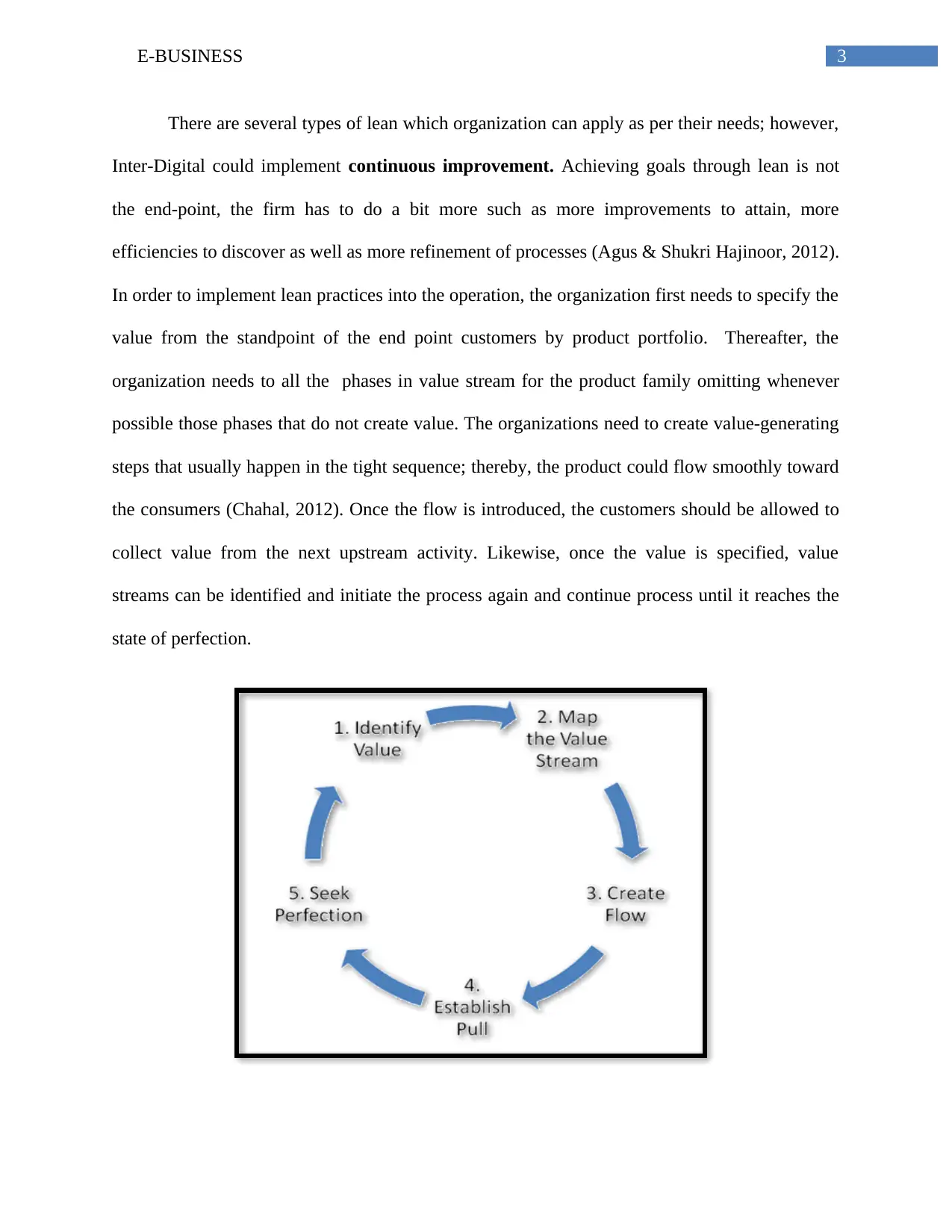
3E-BUSINESS
There are several types of lean which organization can apply as per their needs; however,
Inter-Digital could implement continuous improvement. Achieving goals through lean is not
the end-point, the firm has to do a bit more such as more improvements to attain, more
efficiencies to discover as well as more refinement of processes (Agus & Shukri Hajinoor, 2012).
In order to implement lean practices into the operation, the organization first needs to specify the
value from the standpoint of the end point customers by product portfolio. Thereafter, the
organization needs to all the phases in value stream for the product family omitting whenever
possible those phases that do not create value. The organizations need to create value-generating
steps that usually happen in the tight sequence; thereby, the product could flow smoothly toward
the consumers (Chahal, 2012). Once the flow is introduced, the customers should be allowed to
collect value from the next upstream activity. Likewise, once the value is specified, value
streams can be identified and initiate the process again and continue process until it reaches the
state of perfection.
There are several types of lean which organization can apply as per their needs; however,
Inter-Digital could implement continuous improvement. Achieving goals through lean is not
the end-point, the firm has to do a bit more such as more improvements to attain, more
efficiencies to discover as well as more refinement of processes (Agus & Shukri Hajinoor, 2012).
In order to implement lean practices into the operation, the organization first needs to specify the
value from the standpoint of the end point customers by product portfolio. Thereafter, the
organization needs to all the phases in value stream for the product family omitting whenever
possible those phases that do not create value. The organizations need to create value-generating
steps that usually happen in the tight sequence; thereby, the product could flow smoothly toward
the consumers (Chahal, 2012). Once the flow is introduced, the customers should be allowed to
collect value from the next upstream activity. Likewise, once the value is specified, value
streams can be identified and initiate the process again and continue process until it reaches the
state of perfection.
Paraphrase This Document
Need a fresh take? Get an instant paraphrase of this document with our AI Paraphraser
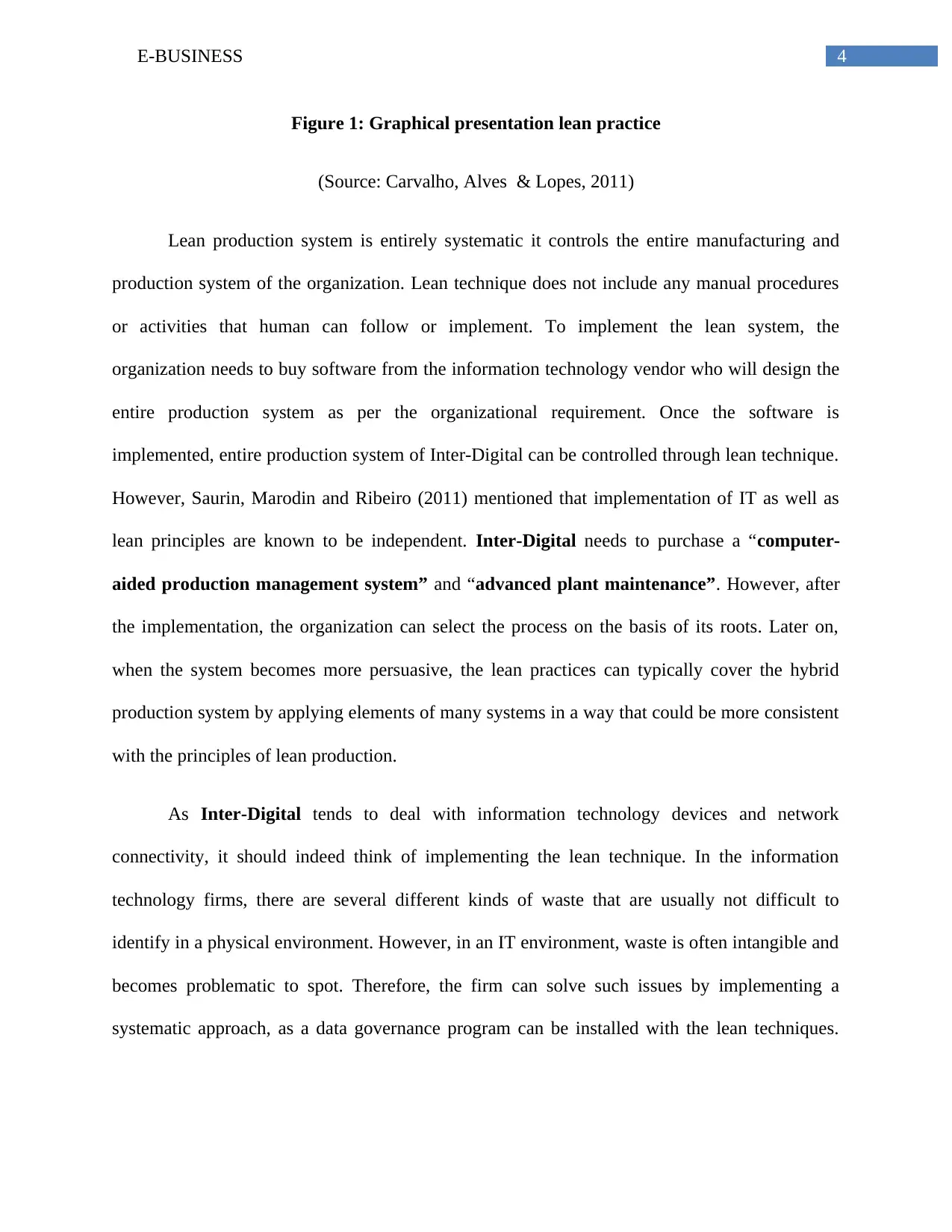
4E-BUSINESS
Figure 1: Graphical presentation lean practice
(Source: Carvalho, Alves & Lopes, 2011)
Lean production system is entirely systematic it controls the entire manufacturing and
production system of the organization. Lean technique does not include any manual procedures
or activities that human can follow or implement. To implement the lean system, the
organization needs to buy software from the information technology vendor who will design the
entire production system as per the organizational requirement. Once the software is
implemented, entire production system of Inter-Digital can be controlled through lean technique.
However, Saurin, Marodin and Ribeiro (2011) mentioned that implementation of IT as well as
lean principles are known to be independent. Inter-Digital needs to purchase a “computer-
aided production management system” and “advanced plant maintenance”. However, after
the implementation, the organization can select the process on the basis of its roots. Later on,
when the system becomes more persuasive, the lean practices can typically cover the hybrid
production system by applying elements of many systems in a way that could be more consistent
with the principles of lean production.
As Inter-Digital tends to deal with information technology devices and network
connectivity, it should indeed think of implementing the lean technique. In the information
technology firms, there are several different kinds of waste that are usually not difficult to
identify in a physical environment. However, in an IT environment, waste is often intangible and
becomes problematic to spot. Therefore, the firm can solve such issues by implementing a
systematic approach, as a data governance program can be installed with the lean techniques.
Figure 1: Graphical presentation lean practice
(Source: Carvalho, Alves & Lopes, 2011)
Lean production system is entirely systematic it controls the entire manufacturing and
production system of the organization. Lean technique does not include any manual procedures
or activities that human can follow or implement. To implement the lean system, the
organization needs to buy software from the information technology vendor who will design the
entire production system as per the organizational requirement. Once the software is
implemented, entire production system of Inter-Digital can be controlled through lean technique.
However, Saurin, Marodin and Ribeiro (2011) mentioned that implementation of IT as well as
lean principles are known to be independent. Inter-Digital needs to purchase a “computer-
aided production management system” and “advanced plant maintenance”. However, after
the implementation, the organization can select the process on the basis of its roots. Later on,
when the system becomes more persuasive, the lean practices can typically cover the hybrid
production system by applying elements of many systems in a way that could be more consistent
with the principles of lean production.
As Inter-Digital tends to deal with information technology devices and network
connectivity, it should indeed think of implementing the lean technique. In the information
technology firms, there are several different kinds of waste that are usually not difficult to
identify in a physical environment. However, in an IT environment, waste is often intangible and
becomes problematic to spot. Therefore, the firm can solve such issues by implementing a
systematic approach, as a data governance program can be installed with the lean techniques.
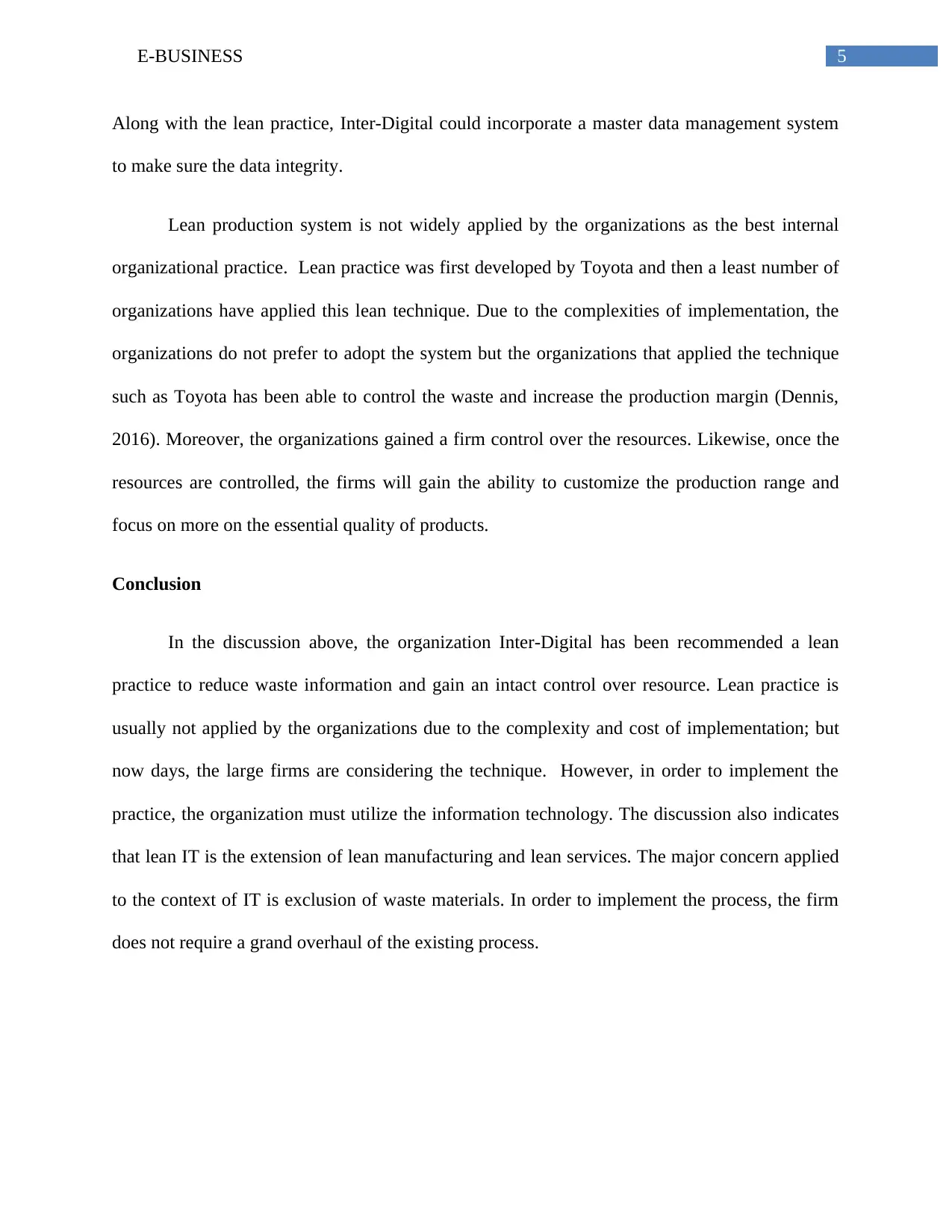
5E-BUSINESS
Along with the lean practice, Inter-Digital could incorporate a master data management system
to make sure the data integrity.
Lean production system is not widely applied by the organizations as the best internal
organizational practice. Lean practice was first developed by Toyota and then a least number of
organizations have applied this lean technique. Due to the complexities of implementation, the
organizations do not prefer to adopt the system but the organizations that applied the technique
such as Toyota has been able to control the waste and increase the production margin (Dennis,
2016). Moreover, the organizations gained a firm control over the resources. Likewise, once the
resources are controlled, the firms will gain the ability to customize the production range and
focus on more on the essential quality of products.
Conclusion
In the discussion above, the organization Inter-Digital has been recommended a lean
practice to reduce waste information and gain an intact control over resource. Lean practice is
usually not applied by the organizations due to the complexity and cost of implementation; but
now days, the large firms are considering the technique. However, in order to implement the
practice, the organization must utilize the information technology. The discussion also indicates
that lean IT is the extension of lean manufacturing and lean services. The major concern applied
to the context of IT is exclusion of waste materials. In order to implement the process, the firm
does not require a grand overhaul of the existing process.
Along with the lean practice, Inter-Digital could incorporate a master data management system
to make sure the data integrity.
Lean production system is not widely applied by the organizations as the best internal
organizational practice. Lean practice was first developed by Toyota and then a least number of
organizations have applied this lean technique. Due to the complexities of implementation, the
organizations do not prefer to adopt the system but the organizations that applied the technique
such as Toyota has been able to control the waste and increase the production margin (Dennis,
2016). Moreover, the organizations gained a firm control over the resources. Likewise, once the
resources are controlled, the firms will gain the ability to customize the production range and
focus on more on the essential quality of products.
Conclusion
In the discussion above, the organization Inter-Digital has been recommended a lean
practice to reduce waste information and gain an intact control over resource. Lean practice is
usually not applied by the organizations due to the complexity and cost of implementation; but
now days, the large firms are considering the technique. However, in order to implement the
practice, the organization must utilize the information technology. The discussion also indicates
that lean IT is the extension of lean manufacturing and lean services. The major concern applied
to the context of IT is exclusion of waste materials. In order to implement the process, the firm
does not require a grand overhaul of the existing process.
⊘ This is a preview!⊘
Do you want full access?
Subscribe today to unlock all pages.

Trusted by 1+ million students worldwide
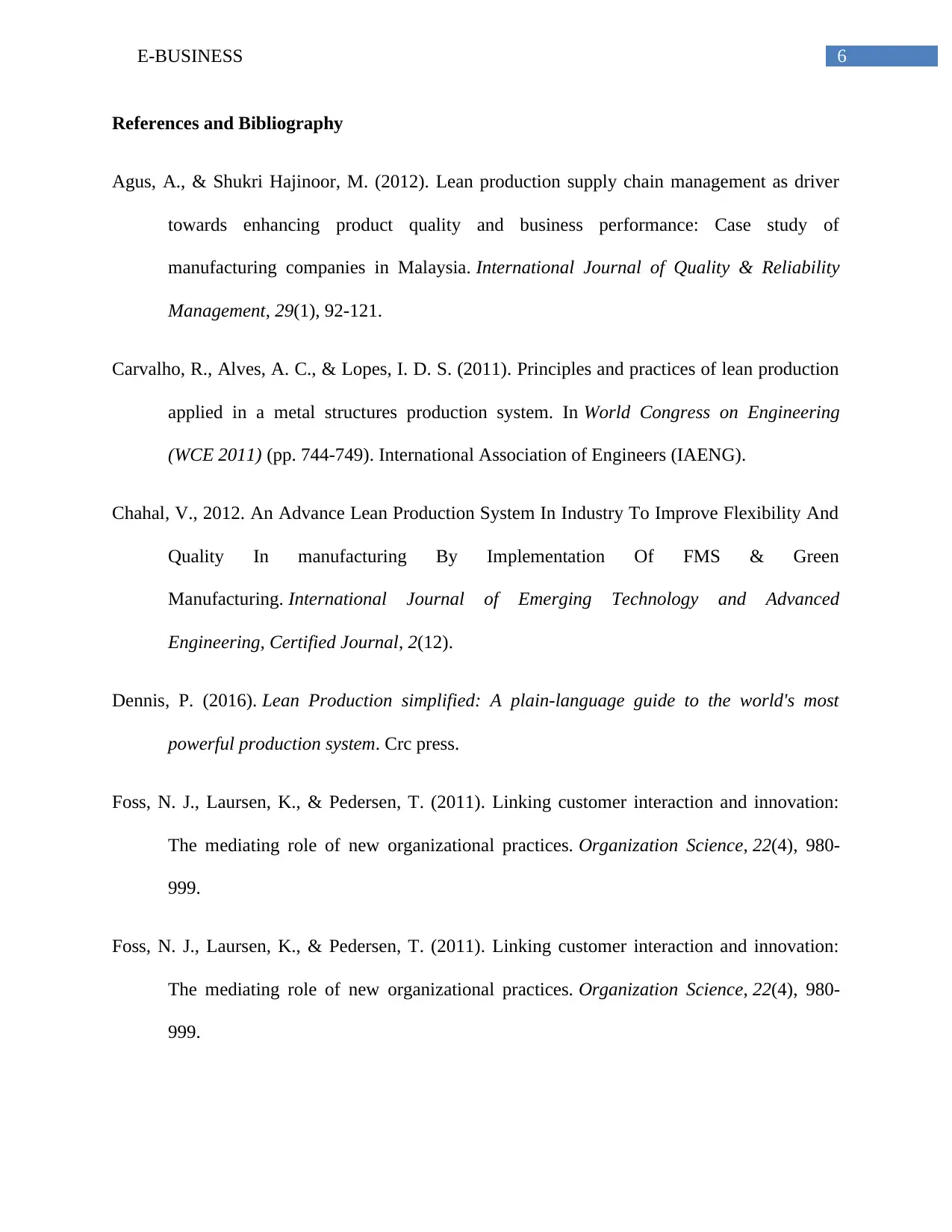
6E-BUSINESS
References and Bibliography
Agus, A., & Shukri Hajinoor, M. (2012). Lean production supply chain management as driver
towards enhancing product quality and business performance: Case study of
manufacturing companies in Malaysia. International Journal of Quality & Reliability
Management, 29(1), 92-121.
Carvalho, R., Alves, A. C., & Lopes, I. D. S. (2011). Principles and practices of lean production
applied in a metal structures production system. In World Congress on Engineering
(WCE 2011) (pp. 744-749). International Association of Engineers (IAENG).
Chahal, V., 2012. An Advance Lean Production System In Industry To Improve Flexibility And
Quality In manufacturing By Implementation Of FMS & Green
Manufacturing. International Journal of Emerging Technology and Advanced
Engineering, Certified Journal, 2(12).
Dennis, P. (2016). Lean Production simplified: A plain-language guide to the world's most
powerful production system. Crc press.
Foss, N. J., Laursen, K., & Pedersen, T. (2011). Linking customer interaction and innovation:
The mediating role of new organizational practices. Organization Science, 22(4), 980-
999.
Foss, N. J., Laursen, K., & Pedersen, T. (2011). Linking customer interaction and innovation:
The mediating role of new organizational practices. Organization Science, 22(4), 980-
999.
References and Bibliography
Agus, A., & Shukri Hajinoor, M. (2012). Lean production supply chain management as driver
towards enhancing product quality and business performance: Case study of
manufacturing companies in Malaysia. International Journal of Quality & Reliability
Management, 29(1), 92-121.
Carvalho, R., Alves, A. C., & Lopes, I. D. S. (2011). Principles and practices of lean production
applied in a metal structures production system. In World Congress on Engineering
(WCE 2011) (pp. 744-749). International Association of Engineers (IAENG).
Chahal, V., 2012. An Advance Lean Production System In Industry To Improve Flexibility And
Quality In manufacturing By Implementation Of FMS & Green
Manufacturing. International Journal of Emerging Technology and Advanced
Engineering, Certified Journal, 2(12).
Dennis, P. (2016). Lean Production simplified: A plain-language guide to the world's most
powerful production system. Crc press.
Foss, N. J., Laursen, K., & Pedersen, T. (2011). Linking customer interaction and innovation:
The mediating role of new organizational practices. Organization Science, 22(4), 980-
999.
Foss, N. J., Laursen, K., & Pedersen, T. (2011). Linking customer interaction and innovation:
The mediating role of new organizational practices. Organization Science, 22(4), 980-
999.
Paraphrase This Document
Need a fresh take? Get an instant paraphrase of this document with our AI Paraphraser
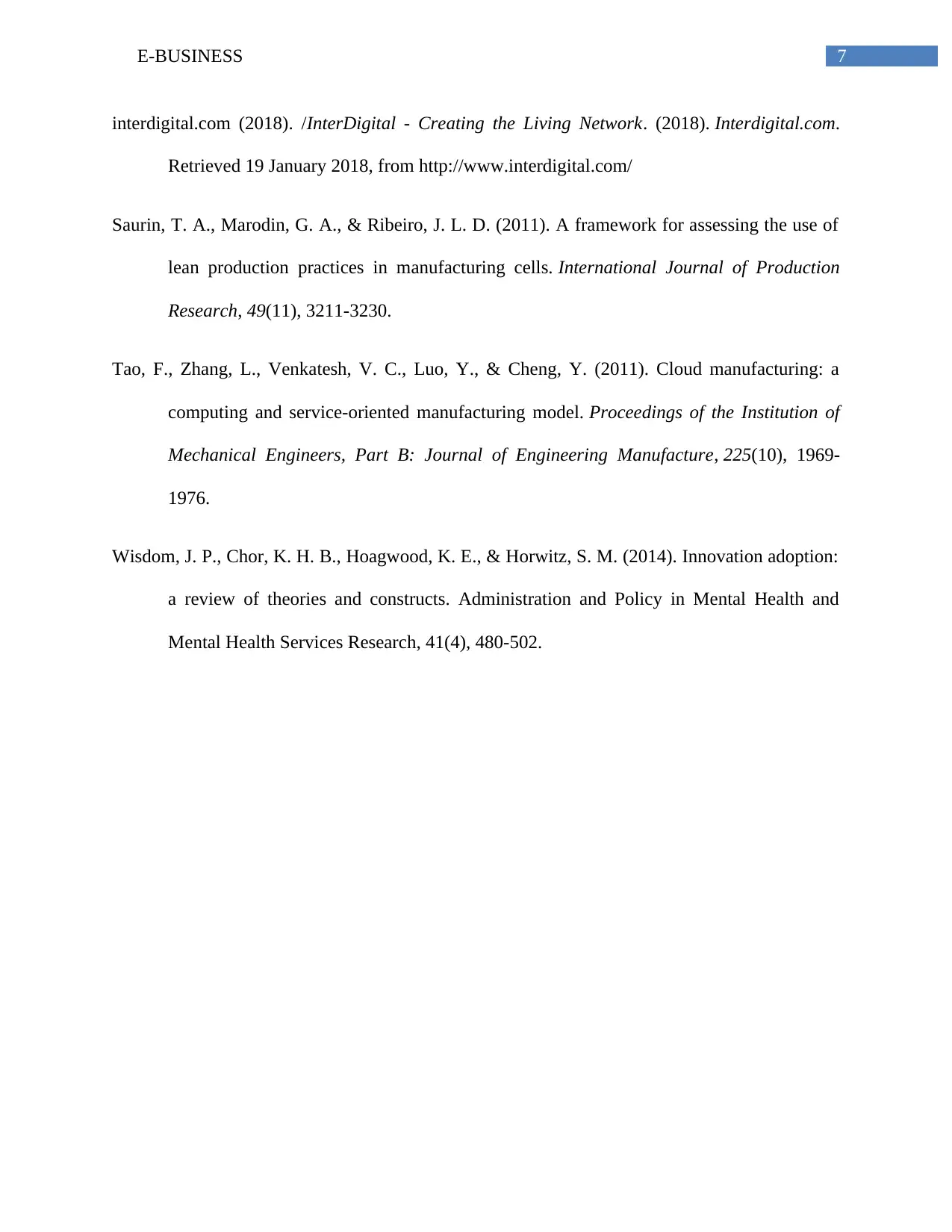
7E-BUSINESS
interdigital.com (2018). /InterDigital - Creating the Living Network. (2018). Interdigital.com.
Retrieved 19 January 2018, from http://www.interdigital.com/
Saurin, T. A., Marodin, G. A., & Ribeiro, J. L. D. (2011). A framework for assessing the use of
lean production practices in manufacturing cells. International Journal of Production
Research, 49(11), 3211-3230.
Tao, F., Zhang, L., Venkatesh, V. C., Luo, Y., & Cheng, Y. (2011). Cloud manufacturing: a
computing and service-oriented manufacturing model. Proceedings of the Institution of
Mechanical Engineers, Part B: Journal of Engineering Manufacture, 225(10), 1969-
1976.
Wisdom, J. P., Chor, K. H. B., Hoagwood, K. E., & Horwitz, S. M. (2014). Innovation adoption:
a review of theories and constructs. Administration and Policy in Mental Health and
Mental Health Services Research, 41(4), 480-502.
interdigital.com (2018). /InterDigital - Creating the Living Network. (2018). Interdigital.com.
Retrieved 19 January 2018, from http://www.interdigital.com/
Saurin, T. A., Marodin, G. A., & Ribeiro, J. L. D. (2011). A framework for assessing the use of
lean production practices in manufacturing cells. International Journal of Production
Research, 49(11), 3211-3230.
Tao, F., Zhang, L., Venkatesh, V. C., Luo, Y., & Cheng, Y. (2011). Cloud manufacturing: a
computing and service-oriented manufacturing model. Proceedings of the Institution of
Mechanical Engineers, Part B: Journal of Engineering Manufacture, 225(10), 1969-
1976.
Wisdom, J. P., Chor, K. H. B., Hoagwood, K. E., & Horwitz, S. M. (2014). Innovation adoption:
a review of theories and constructs. Administration and Policy in Mental Health and
Mental Health Services Research, 41(4), 480-502.
1 out of 8
Related Documents
Your All-in-One AI-Powered Toolkit for Academic Success.
+13062052269
info@desklib.com
Available 24*7 on WhatsApp / Email
![[object Object]](/_next/static/media/star-bottom.7253800d.svg)
Unlock your academic potential
Copyright © 2020–2025 A2Z Services. All Rights Reserved. Developed and managed by ZUCOL.





